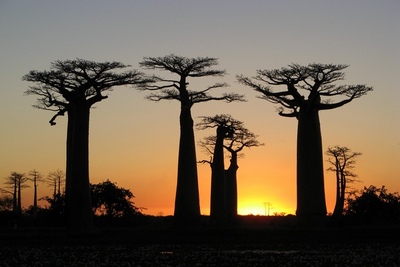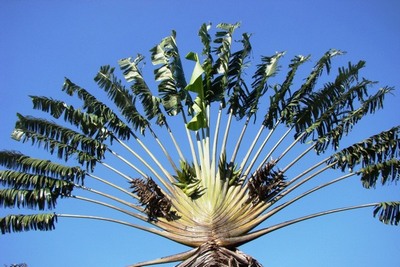Home > Africa > Madagascar > Explorer



MADAGASCAR
馬達加斯加
Andasibe National Park
Andasibe covers an area of montane rainforest at altitudes between 930 metres and 1,040 metres. It is the best park for the indri, the largest lemur, and two of the 62 resident groups have been habituated, making them easy to see. There are eight other species of lemur in Andasibe and the most common seen include the grey bamboo lemurs, brown lemurs and woolly lemurs. There are some wonderful chameleons in the reserve including the two-foot long Parson's chameleon and the tiny nose-homed chameleon. Frogs are plentiful and birding highlights include Madagascar blue pigeon, coral-billed nuthatches and the Madagascar long-eared owl. Alll exploring is done on foot along trails that weave through the forest: expeditions can vary in length from one hour to five. Walks are particularlly rewarding in the early morning when indri calls, sounding rather like a weird forest whalesong, echo through the air.
The Pangalanes Canal
Running parallel to the Indian Ocean the Pangalanes Canal forms a network of man-made channels connecting fresh water lakes and lagoons. Stretching 600 kilometres from the bustling port of Tamatave to Farafangana along the south east coast, the Pangalanes is the longest canal in the world. Though overgrown with aquatic plants the canal still dominates daily life in this region as it provides the main source of trade and transport. Plans are in place to clear the weed and upgrade the canal once more to the busy commerical waterway that it once was. Cruising by boat on the calm waters of Pangalanes is fascinating. This area is the strongold of the Betsimisaraka people and their villages can be seen along the banks. On the waterways themselves you see pirogues, lcoal fishermen, rafts carrying timber and over-crowded ferries with names such as "Great Hopes" and "Malagasy Fish".
Masoala National Park
Masoala National Park is Madagascar's largest park and one of its least visited. Primary rainforest covers a range of mountains and drops down to the deserted beaches of Antongli Bay where hump-backed whales come to breed and calve. The Masoala rainforst is beautiful wiht tall pallisander trees, vines, wild ginger plants, ferns and orchids. Walking in the forest you see hundreds of frogs, including the large tomato frog. Chameleons are easily found: the most commonly-seen species include the panther chameleon, hooded chameleon and several species of stump-tailed chameleon. Masoala is the lst refuge of the red-ruffed lemur which sun themselves on the top of trees in the morning. At night you often see eastern wolly lemurs sitting in the tree forks and white-fronted brown lemur, brown mouse lemur and the aye-aye are also resident. On the ground a surprising number of lowland streaked tenrecs rustle through the vegetation in their endless search of insects.
Nosy Mangabe
Nosy Mangabe is a small island located in Antongil Bay two kilometres offshore from Maroantsetra. The island has a rich history of piracy and arrivng by boat it looks exactly like a pirates' hang-outlll Dense vegetation drops to large boulders and hidden coves - one of which has a rusty shipwreck emerging from the shallows. The island is a rainforest reserve the sanctuary for the endangered aye-aye which was introduced in 1966. This is the best place in Madagascar to see these fascinating creatures and an overnight stay is recommended to give you the chance to search by torchlight. Other lemurs on the island include black and white ruffed lemur, white-fronted brown lemur and the brown mouse lemur. As there is no accommodation on the island the only way to stay overnight is to camp. Path through the forest can be steep so it's a place for nimble walks.
Amber Mountain National Park
Amber Mountain National Park is situated in the far north of Madagascar, 40 kilometres south of Diego Suarez Whilst Diego can be hot and dry Amber Mountain is always cool and fresh with mist hanging over the trees. There are huge stangler figs, quinine trees and enomous birds-nest ferns. The park is rewarding for walkers with several beautiful trails threading through the forst. Two trails lead to waterfalls, the Cascade d'Antomboka and Cascade Sacree. On foot you have the chance to discover all the small wildlife such as the leaf-mimic chameleons, tree boas, leaf-tailed geckos, butterflies, and pill millipedes which curl up into perfect balls. There are several lemur species in the park, including the crowned lemur and Sanford's brown lemur, and hikers usually see at least one if not two of the diumal species.
Ranomafana National Park
Ranomafana National Park is part of the lush chain of rainforest that runs down Madagascar's east coast. The steep hills are covered in thick vegetation, occasionally broken by waterfalls and mountain streams. The park's star attraction is the golden bamboo lemur, often found grazing amongst the bamboo thickets. Eleven other species of lemur include diademed sifakas that leap through the canopy during the day and brown mouse lemurs who race up and down tree trunks by night. Heading deep into the park, you may hear the calls of cuckoo rollers, catch a glimpse of a leaf-tailed gecko or stumble across the graves of the Tanala, "the people of the forest". It is well worth spending a few days hiking around this enchanting park.
Antsirabe
Antsirabe is a small spa town roughly half way between Antananarivo and Ranomafana. Signs of its colonist past can still be seen today in the town's wide boulevards, imposing cathedral and crumbling white villas, enlivened by countless signs of Madagascar today including the colorful pousse-pousses that race along the town's streets, all brightly coloured, and each with their own name and number plate! Numerous stalls cluster on each street corner selling everything from bananas to spare bicycle parts. The cool, clear air of the high plateau makes Antsirabe an attractive stop on the route to the south, and it is an excellent place to see local craftsmen at work; hundreds of tiny workshops are scattered across town, making sweets, delicate lacework and tiny model bicycle. A visit to the thermal baths is also fun and you'll find a wonderfully hot swimming pool full of a lot of splashing and laughter.
Isalo National Park
Isalo's golden sandstone cliffs can be seen rising out of the plains from many miles away. The national park is home to some of Madagscar's most stunning scenery, and is a sacred place for the Bara tribe, whoose burial sites are marked by mounds of tiny stones placed in crevies in th rock face. Hiking up to the massif, visitors enter a barren wonderland of twisted rock formations and extraordinary plants, shimmering in the heat of the plateau. Squat elephant's foot plants cling to the rocks, a a few dry grasses blow in the wind, and succulent aloes thrive. Wildlife concentrates in the numerous shady gorges and cool running streams that carve thorugh the massif. Deciduous woodland grows in each canyon's higher levels, and it is here that Isalo's lemurs are most often found. Brown lemurs feed amongst the branches, Verreaux's sifakas leap from rock to rock, and troops of cheeky ringtails wander along the pathways.
Descending deeper into the gorges, only a few shafts of sunlight penetrate to the streams below, and dripping mosses and ferns line the walls. Occasionally the streams become blocked, forming tiny tropical pools amongst the rocks. The clear air, tumbling waterfalls, and cool water almost defy belief, and make a wonderful respite from a hot day's hiking on the plateau.
Berenty Reserve
One of Madagascar's best known widlife reserves, Berenty is set on the banks of the Mandrare River. Strolling through the gallery forest you could be forgiven for thinking you were in the English countryside - though a flicker of movement in the canopy or a rustle amongst the leaves will soon prove you wrong. Troupes of ring-tailed lemurs race along the dappled pathways, happily fearless of their human guests. Verreaux's sifakas leap from tree to tree, occasionally descending to earth to triplejump, arms raised high, across the sand. Red-fronted brown lemurs have been introduced into the forest and can easily be spotted eating fruit and leaves. Bird watching, even without binoculars, is excellent here: look out for flashes of blue on the faces of giant couas, and the long tails of paradise flycatchers. Alongside Berenty's deciduous woodland, a small area of spiny forest is excellent for night walks. As moonlight filters through the twisted fingers of euphorbia and octopus trees a powerful torch will pick out the eyes of curious lemurs, flashes of green against the inky night. Mouse lemurs are ever active, flickering fast up and down silhouetted trees, and sportive lemurs can be found by following their eerie call. Stepping out of the forest at the end of a night walk, the sweep of stars across the sky is magnificent: a few minutes stargazing are the perfect prelude to a night at your lodge.
All information above are given for reference only. They are subject to change without giving prior notice.
Our private tailor-made journeys offer complete freedom of choice. The itinerary and accommodation are designed to give you a flavour of what is possible and can be tailored to suit your preferences. Prices vary according to your selected accommodation and season, please feel free to contact our Travel Specialists for information and enquiry.
|
|---|
Newsletter Subscription: 訂閱最新旅遊資訊
Site Map · Privacy Policy 私隱政策(只附英文版)
© 2020 Exotic-Holidays.hk · All Rights Reserved.
![]()